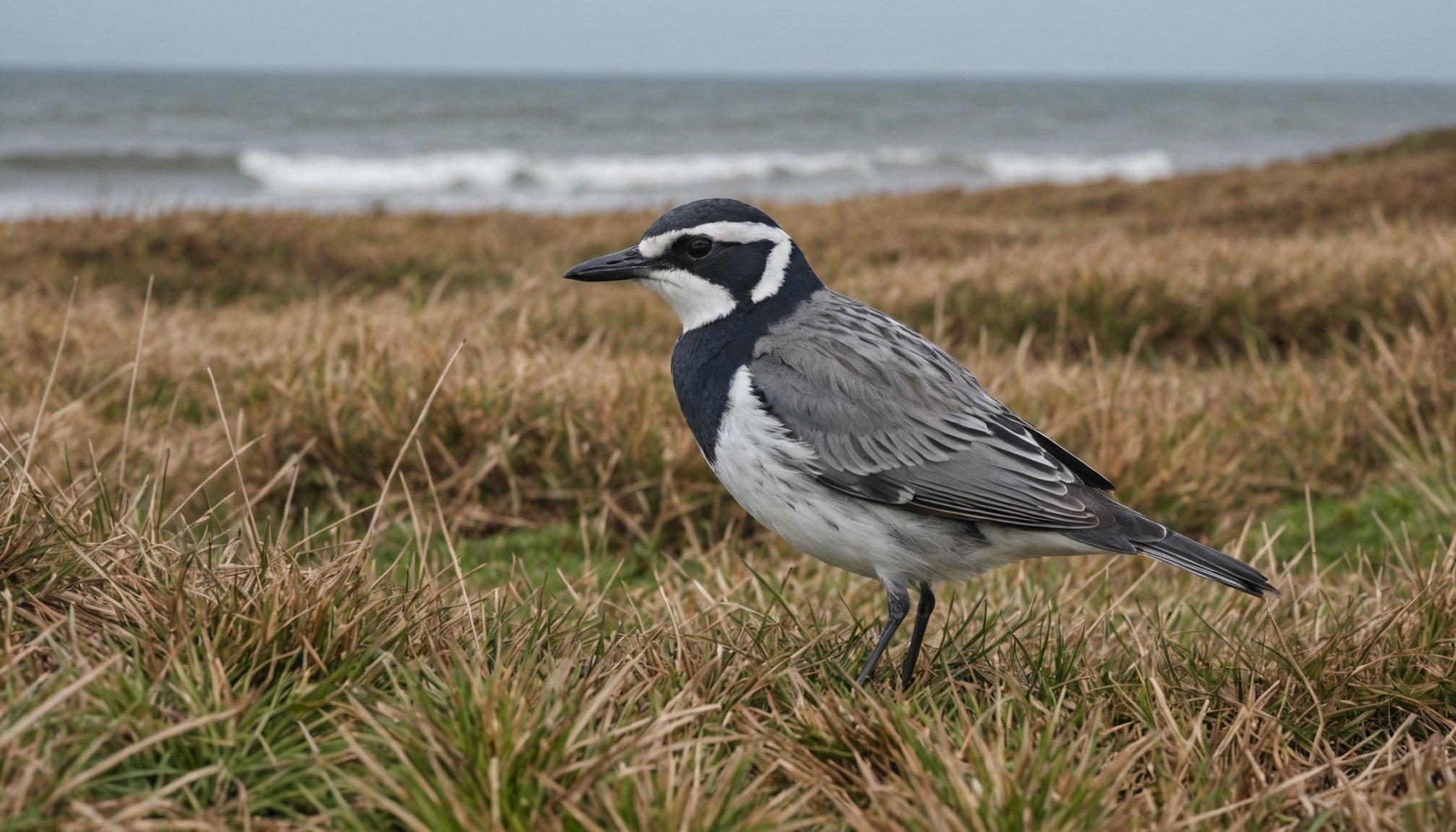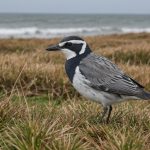How Climate Change Influences Coastal Bird Populations in the UK: Unveiling the Impact
Understanding the Context of Climate Change and Bird Populations
Climate change is one of the most pressing issues of our time, and its effects are far-reaching, impacting various aspects of our environment, including coastal bird populations. In the UK, these populations are particularly vulnerable due to the country’s unique geographical position and the diverse range of bird species that call its coasts home.
To grasp the full extent of the impact, it’s essential to understand the broader context of climate change. Global warming, driven by the increase in carbon emissions, is leading to rising temperatures, sea level rise, and changes in weather patterns. These changes have a cascading effect on ecosystems, particularly those in coastal areas.
Also read : Effective approaches for uk residents to minimize bird strikes on skyscrapers
The Effects of Climate Change on Coastal Habitats
Coastal habitats, such as wetlands, estuaries, and beaches, are crucial for many bird species. However, these areas are highly susceptible to the effects of climate change.
Sea Level Rise and Coastal Erosion
One of the most immediate impacts is the rise in sea levels, which leads to coastal erosion and the loss of habitats. As the sea encroaches on land, it destroys nesting sites, feeding grounds, and breeding areas for many bird species. For example, the saltmarshes and mudflats that are vital for migratory birds like the Redshank and the Curlew are being eroded at an alarming rate[2].
Topic to read : Enhancing urban biodiversity: the transformative role of rooftop gardens in the uk
Changes in Weather Patterns
Changes in weather patterns also play a significant role. Increased frequency and intensity of storms can disrupt breeding cycles and destroy nests. For instance, the breeding season of the Puffin, a iconic UK coastal bird, is often disrupted by severe storms that can wipe out entire colonies of chicks and eggs.
Shifts in Food Availability
Climate change also affects the availability of food for coastal birds. Rising temperatures alter the distribution and abundance of fish, crustaceans, and other marine life that birds rely on for sustenance. This can lead to malnutrition and decreased survival rates among bird populations.
Impact on Specific Bird Species
Different bird species are affected in various ways by climate change.
Migratory Birds
Migratory birds, such as the Arctic Tern and the Barn Swallow, face significant challenges. Changes in temperature and weather patterns can disrupt their migratory routes and timing, leading to mismatches between the birds’ arrival and the availability of food resources. For example, the arrival of migratory birds in the UK may no longer coincide with the peak abundance of insects and other food sources, leading to a decrease in their populations[3].
Breeding and Nesting
Breeding and nesting habits are also impacted. Many coastal bird species rely on specific habitats for breeding, such as the Little Tern, which nests on sandy beaches. However, these habitats are increasingly threatened by rising sea levels and increased storm activity. The loss of these habitats can lead to a significant decrease in breeding success and population numbers.
Human Activities and Climate Change Mitigation
While climate change itself is a major threat, human activities can either exacerbate or mitigate these effects.
Renewable Energy and Wind Farms
The development of renewable energy, such as wind farms, is crucial for reducing carbon emissions and mitigating climate change. However, these installations can also have negative impacts on bird populations. For instance, wind turbines can increase the mortality of migratory birds, especially those that fly at night or in low visibility conditions[4].
Conservation Efforts
Conservation efforts are vital for protecting coastal bird populations. Organizations and governments are working to restore and protect habitats, such as the restoration of wetlands and the creation of artificial nesting sites. For example, the Royal Society for the Protection of Birds (RSPB) has been involved in numerous projects to protect and restore coastal habitats, including the creation of managed realignment sites to allow natural coastal processes to occur while protecting bird habitats.
Practical Insights and Actionable Advice
So, what can we do to help mitigate the impact of climate change on coastal bird populations?
Support Conservation Efforts
Supporting organizations involved in conservation work is crucial. Donations, volunteering, and spreading awareness can all contribute to the protection of coastal habitats.
Reduce Carbon Footprint
Reducing our individual carbon footprint can help mitigate the effects of climate change. Simple actions like using public transport, reducing energy consumption, and supporting renewable energy projects can make a significant difference.
Advocate for Policy Changes
Advocating for policy changes that support climate change mitigation and conservation is also important. Supporting policies that protect natural habitats and promote sustainable development can help ensure the long-term survival of coastal bird populations.
Table: Impact of Climate Change on Coastal Bird Populations
| Aspect of Climate Change | Impact on Coastal Bird Populations | Examples of Affected Species |
|---|---|---|
| Sea Level Rise | Loss of habitats, increased coastal erosion | Redshank, Curlew |
| Changes in Weather Patterns | Disruption of breeding cycles, nest destruction | Puffin |
| Shifts in Food Availability | Malnutrition, decreased survival rates | Arctic Tern, Barn Swallow |
| Human Activities (Wind Farms) | Increased mortality due to wind turbines | Migratory birds |
| Conservation Efforts | Protection and restoration of habitats | Little Tern, various species |
Quotes from Experts
- “Climate change is one of the most significant threats to bird populations globally. The UK’s coastal birds are particularly vulnerable due to the country’s unique geography and the diversity of species found here.” – Dr. Mark Avery, Former Conservation Director, RSPB.
- “The impact of climate change on coastal habitats is multifaceted. It’s not just about sea level rise; it’s about changes in weather patterns, food availability, and human activities. We need a comprehensive approach to mitigate these effects.” – Dr. Pearce-Higgins, Climate Change Scientist.
The impact of climate change on coastal bird populations in the UK is profound and multifaceted. From sea level rise and changes in weather patterns to shifts in food availability and the effects of human activities, the challenges are numerous. However, by understanding these impacts and taking practical steps to mitigate them, we can work towards a future where these incredible species continue to thrive.
Here are some key takeaways:
- Support Conservation: Back organizations working to protect and restore coastal habitats.
- Reduce Carbon Footprint: Make individual changes to reduce your carbon footprint.
- Advocate for Policy Changes: Support policies that protect natural habitats and promote sustainable development.
By working together, we can ensure that the beautiful and diverse coastal bird populations of the UK continue to flourish despite the challenges posed by climate change.
Overview of Coastal Bird Populations in the UK
Understanding the coastal bird populations in the UK is crucial for conservation. The varied UK landscapes support a rich tapestry of avian diversity, housing numerous bird species that rely heavily on these habitats. Recent studies indicate varying fortunes for different species. While some thrive, others experience declines, particularly due to climate change impacts.
Key affected species include the puffin and the kittiwake. Their survival is teetering as changing sea temperatures and food scarcity alter their natural habitats. These changes, driven by shifting climatic conditions, underscore the precarious status of certain bird species.
Coastal habitats are of paramount importance for avian diversity. The UK’s coastlines provide vital feeding and breeding grounds for millions of birds. Here, diverse ecosystems offer shelter and sustenance, essential for maintaining robust populations. These areas not only support local bird species but also serve as crucial stopovers for migratory birds.
Preservation of these habitats is thus vital. Conservation efforts must maintain and protect the delicate ecological balance necessary for thriving coastal bird populations. As climate challenges persist, protecting these environments ensures the survival of the UK’s rich avian diversity. Understanding and addressing these issues can help safeguard bird species for future generations.
Effects of Climate Change on Bird Behavior
The shifts in bird behavior due to climate change are becoming increasingly evident and impactful. One of the most significant changes observed is in migration patterns. As temperature anomalies emerge, many bird species are adjusting their migration timings to align with unusual climate conditions. For instance, some birds now migrate earlier in the spring or delay their departure in the autumn as they adapt to warmer temperatures.
Breeding behavior is also undergoing transformations. Variations in climate often result in unpredictable weather patterns, which can alter breeding routines. Birds might breed sooner or lay fewer eggs as a response to the changing environment, directly influencing their population dynamics.
Moreover, a shift in climate affects food availability, consequently impacting foraging strategies. Birds may expand their foraging range in search of sufficient food supplies or alter their diets to incorporate new types of prey. These adaptive strategies show birds’ resilience yet indicate the profound influence climate change exerts on natural processes.
As these behavioral changes continue, studying and understanding them becomes crucial. By recognizing these adaptive strategies, we can gain insights into the resilience of bird species and address broader ecological implications.
Habitat Loss and Alteration
Human activities have left a significant imprint on various coastal ecosystems, often leading to substantial habitat loss. Sea-level rise represents one of the pressing concerns, reshaping vulnerable coastal and marine environments. As seas encroach inland, breeding grounds once vital for diverse species face imminent threats, shrinking habitats in once-safe areas.
Impact of Sea-Level Rise
The increase in sea levels specifically affects breeding grounds by inundating beaches and wetlands, reducing the available space for wildlife to nest and rear young. This further results in intensified competition for these limited spaces among species, altering the dynamics of these ecosystems.
Changes in Vegetation
Moreover, these encroaching waters shift vegetation patterns, directly impacting nesting behaviors. As saltwater infiltrates freshwater systems, plant species that previously thrived may decline, replaced by others more resilient to salinity, thus forcing wildlife to adapt or relocate.
Anthropogenic Pressures
Human actions further compound these issues, imposing additional pressure on already fragile environments. Urban development, deforestation, and pollution exacerbate habitat degradation. Activities such as coastal construction and oil drilling escalate habitat loss, leaving harmful long-lasting effects. Recognizing and mitigating these human impacts is crucial in safeguarding such ecosystems for the future.
Case Studies on Coastal Bird Populations
In avian research, several case studies document how UK coastal birds are adapting to the challenges posed by climate change. These adaptations are often seen in shifts in migration patterns, breeding timings, and habitat preference.
For instance, some coastal bird species are adjusting their breeding seasons to align with warmer temperatures, ensuring that their chicks hatch during peak food availability. This change helps offset the effects of climate fluctuations on their food sources, predominantly marine life.
Regional studies reveal significant alterations in population dynamics. In recent years, there has been a notable increase in the UK populations of species such as the Little Egret, traditionally found in warmer climates. This shift points to a northward movement facilitated by milder winters and the availability of appropriate nesting sites.
However, not all changes are positive. The numbers of species like the Atlantic Puffin are declining due to disrupted fish supplies, caused by warming seas and overfishing.
Various regional studies serve as valuable tools in understanding these changes. They highlight the resilience and adaptability of certain species, while also stressing the urgent need for conservation efforts to protect vulnerable avian populations from the accelerating pace of climate change.
Conservation Strategies and Mitigation Efforts
In the UK, conservation strategies play a crucial role in safeguarding biodiversity. Bird protection is a key focus within these efforts, as birds are critical to maintaining healthy ecosystems. Various ongoing projects aim to restore natural habitats and ensure the survival of numerous bird species.
Ecosystem management encompasses a range of strategies, including habitat restoration and protection. Efforts are geared towards re-establishing native flora and fauna, controlling invasive species, and creating protected areas where wildlife can thrive. By focusing on different environmental aspects, these strategies promote overall biodiversity.
Community involvement is another significant element in these conservation activities. Citizen science initiatives encourage local participation, offering individuals the opportunity to contribute to ongoing projects. These programmes not only foster a deeper understanding of environmental issues but also empower communities to take ownership of conservation efforts.
Recent projects have shown that integrating local knowledge and scientific data leads to more effective ecosystem management. By enlisting volunteers in surveys and monitoring activities, conservation bodies can gather extensive data that informs future strategies.
Such cooperative approaches emphasise the importance of collective action in achieving long-term environmental sustainability. As these initiatives progress, they provide valuable insights into the development of adaptive and resilient conservation strategies that can be applied globally.
Expert Opinions and Insights
Exploring perspectives from avian biologists provides us with keen insights into current trends affecting bird populations. These experts emphasize that the role of climate impact research cannot be understated when analysing shifts in bird habitats. Ornithologists, specialists in this domain, have noted that changing weather patterns, driven by climate change, significantly impact bird migration and breeding cycles.
These scientific observations are crucial. As expert analysis becomes available, it informs policy decisions critical for conservation efforts. Policymakers rely on the latest comprehensive studies to make informed decisions that may help mitigate adverse effects on ecosystems.
The anticipations for coastal bird populations, particularly in the UK, over the coming years warrant close attention. Future predictions by biologists suggest that ongoing climate changes could lead to more pronounced shifts in bird distribution and behavior. Some species might face the risk of drastic habitat reduction, posing questions about their survival and adaptability.
Given these challenges, ongoing scientific research is essential to equip conservationists and governments with actionable data. Initiatives derived from this research can foster environments that support bird populations amidst evolving climatic conditions. Continued collaboration between scientists and policymakers will be pivotal in addressing these ecological concerns effectively.
Visualizing the Impact
In today’s rapidly changing world, understanding the effects of climate change on bird populations requires both insight and accessibility. Infographics play a crucial role in this process by transforming complex data into clear, engaging visuals. These powerful tools distill vast amounts of information into easily digestible formats, making it simpler for the public to grasp the extent of changes in bird populations.
For instance, data visualization can effectively depict variations in bird species over time, allowing individuals to perceive trends that may not be immediately apparent in raw data. By portraying these trends, infographics highlight the urgency of environmental challenges and encourage informed decision-making.
One of the most compelling forms of data visualization is climate impact maps. These maps provide a vivid representation of habitat loss and shifting migration patterns due to climate fluctuations. By mapping these changes, individuals can better comprehend the dynamic nature of bird ecosystems and the threats they face.
Integrating these visual tools not only enhances public understanding but also fosters a deeper connection with the natural world. Such engagement is essential for inspiring collective action towards more sustainable future environmental policies. Implementing visuals in environmental discourse ensures that crucial information reaches a wider audience effectively.
Overview of Climate Change Effects on Coastal Ecosystems
Climate change is exerting profound impacts on coastal ecosystems worldwide, influencing both biodiversity and habitat stability. As global temperatures rise, driven by increased greenhouse gas emissions, it is crucial to comprehend how these changes affect coastal environments. These ecosystems support a multitude of species, offer storm protection, and serve as significant centers for carbon sequestration.
In the UK, coastal bird populations are vital indicators of ecological health. These diverse populations contribute to the balance of coastal ecosystems through their roles in food webs and nutrient cycling. They are now facing unprecedented challenges due to climate change, leading to shifts in distribution and abundance that could disrupt local biodiversity.
One of the most significant consequences of climate change is the rise in sea levels. Coastal habitats such as marshlands, mangroves, and tidal flats are particularly vulnerable. Sea-level rise exacerbates coastal erosion, inundation, and habitat loss, threatening the ecological integrity of these environments. As these habitats shrink, the flora and fauna that depend on them are forced to adapt or relocate, which can have ripple effects throughout the ecosystem.
Understanding these global trends is crucial for developing adaptive strategies to preserve coastal biodiversity and ecosystem functions.
Habitat Alterations for Coastal Birds
Coastal birds are facing significant challenges due to habitat changes that threaten their survival and breeding success. The dynamic nature of coastal habitats requires birds to continuously adapt, showcasing the intricate relationship between species adaptation and environmental shifts.
Changes in Wetland Areas
Wetlands serve as vital breeding grounds and feeding sites for many coastal birds. However, human activities such as urban expansion and agricultural development are leading to wetland degradation. This loss of crucial habitats results in reduced breeding opportunities and food availability, forcing species to adapt to less hospitable environments.
Erosion of Natural Coastlines
Natural coastlines act as essential nesting areas for numerous bird species. Unfortunately, increased shoreline erosion—driven by rising sea levels and human interference—poses significant threats. When these nesting sites vanish, birds are compelled to seek alternative areas, often further inland, which can increase competition for resources and further strain species adaptation.
Impact of Storm Surges
Increased storm intensity and frequent storm surges have a profound impact on habitat stability. Coastal birds rely on predictable environments for nesting and feeding. Storm surges can not only damage or destroy these habitats but also displace species, requiring them to adapt to rapidly changing conditions. This instability poses a significant challenge to their long-term survival.
Food Sources and Availability
In the intricate interplay of marine ecosystems, food scarcity is an ever-present challenge for coastal birds. As ocean temperatures fluctuate, there is a notable shift in prey availability. These changes in distribution can disrupt the delicate ecosystem balance, affecting species both in abundance and location. Coastal birds, which rely heavily on a consistent supply of prey, are particularly impacted when these shifts occur.
Overfishing exacerbates this issue by depleting fish stocks, a crucial food source for many marine birds. By removing large quantities of fish, overfishing disrupts the food chains, leading to decreased prey for birds and heightened competition. This heightened competition can cause birds to alter their feeding habits and expend more energy seeking food.
Seasonal migrations of fish and other prey species also play a significant role. As these prey species move in accordance with seasonal changes, birds must adapt their feeding patterns. During certain times of the year, prey may be more abundant in specific regions, impacting where birds choose to forage and how they meet their dietary needs.
Understanding these dynamics is crucial for predicting how coastal birds may respond to ongoing environmental changes and for developing conservation strategies that address food availability challenges.
Reproductive and Breeding Patterns
Understanding the reproductive success and breeding behaviour of species provides critical insights into their adaptation and survival. Mating seasons often dictate the timing and patterns of breeding, aligning with environmental factors to optimise reproductive outcomes.
Changes in Breeding Timing
Climatic shifts have significantly impacted breeding behaviour, causing alterations in cycles and timing. For example, many species now experience earlier mating seasons, synchronising with seasonal temperature changes. This adjustment aims to enhance reproductive success by ensuring offspring arrival in favourable conditions, yet it raises concerns about mismatches with other ecological factors.
Nesting Success Rates
The statistical analysis of nesting success over recent decades reveals fluctuating success rates. Factors such as habitat loss and food availability are pivotal, influencing breeding behaviour and reproductive success. The correlation between these elements and nesting success is evident across various ecosystems.
Impact of Temperature on Egg Viability
Temperature fluctuations play a crucial role in egg development and viability. Extreme temperatures, whether low or high, can impair egg development, leading to reduced hatch rates. Understanding this impact is vital for predicting future reproductive success under changing climate conditions. It fosters strategies that could mitigate adverse effects on species’ reproductive success, ensuring their continued survival.
Case Studies and Current Research
The intersection of coastal birds and climate change in the UK offers a rich field for study and insight. Several case studies have emerged, showcasing how these factors intertwine to affect specific bird species. Notably, research has shown that birds such as the Little Tern and the Oystercatcher are significantly impacted by environmental changes, particularly in their breeding habitats.
The changing climate has led to altered migration patterns and breeding success rates, which has spurred ongoing research to understand and mitigate these effects. For instance, ongoing research projects have focused on creating climate-resilient habitats and monitoring the impacts of rising sea levels on nesting sites.
Conservation programs such as the RSPB’s Coastal Change Programme have achieved notable success stories by implementing strategies like habitat restoration and nest protection schemes. These programs aim to create sustainable environments for affected species, leveraging data from key studies to inform best practices.
Through such case studies and ongoing research, a clearer picture of the challenges and solutions related to climate change’s impact on coastal birds in the UK is formed, offering guidance for future conservation efforts.
Conservation Strategies and Future Implications
It’s crucial to examine the conservation efforts already in place as well as explore forward-thinking strategies. Effective wildlife policy can safeguard vulnerable species and habitats.
Policy Recommendations
Policies aimed at protection strategies should focus on enforcing stricter wildlife policy regulations. Suggested approaches include creating protected zones and establishing sustainable resource management practices. Such policies can mitigate human impact on coastal ecosystems.
Community Involvement in Conservation
Local communities are pivotal in conservation efforts. Empowering them with resources and education enables active participation in habitat preservation. Encouraging locals to engage in ecotourism and conservation activities ensures sustained protection strategies for wildlife and habitats.
Future Research Directions
Understanding the future implications of today’s actions means prioritising emerging research areas. Enhanced studies focused on mitigation strategies are essential. Investigating the effects of climate change on coastal ecosystems is crucial for developing effective protection strategies.
By implementing strategic policies, engaging communities, and advancing research, the path forward becomes clearer and more attainable for protecting our shared environment. Each sector holds a significant role in ensuring a sustainable future for both wildlife policy and our natural world.











